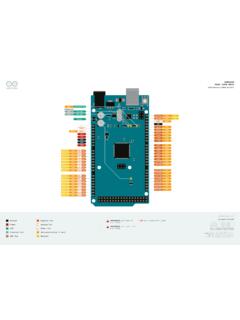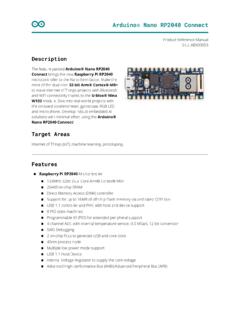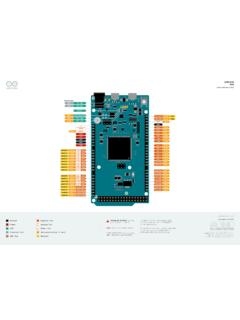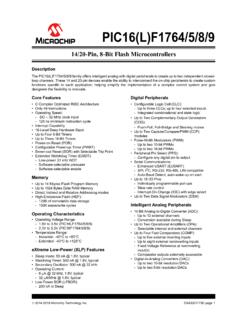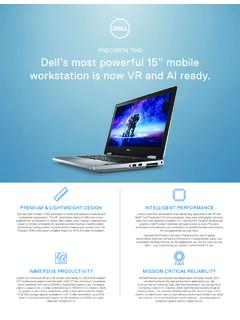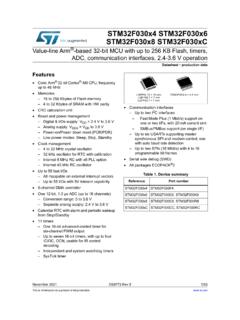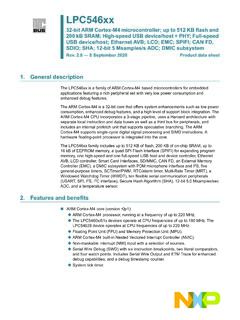Transcription of Arduino Portenta H7
1 Product Reference Manual Features ST STM32H747XI Processor Dual core Arm Cortex -M7 core at up to 480 MHz with double-precision FPU and 16K data + 16K instruction L1 cache Arm 32-bit Cortex -M4 core at up to 240 MHz with FPU, Adaptive real-time accelerator (ART Accelerator ) 2 Mbytes of Flash memory with read-while-write support + 1 Mbyte of RAM Dual mode Quad-SPI memory interface running up to 133 MHz CRC calculation unit Security ROP, PC-ROP, active tamper 3 separate power domains which can be independently clock-gated or switched off: D1: high-performance capabilities D2: communication peripherals and timers D3.
2 Reset/clock control/power management Voltage scaling in Run and Stop mode (6 configurable ranges) A in Standby mode (Backup SRAM OFF, RTC/LSE ON) 4 DMA controllers to unload the CPU 1 high-speed master direct memory access controller (MDMA) with linked list support 2 dual-port DMAs with FIFO 1 basic DMA with request router capabilities Up to 35 communication peripherals 4 I2Cs FM+ interfaces (SMBus/PMBus) 4 USARTs/4x UARTs (ISO7816 interface, LIN, IrDA, up to Mbit/s) and 1x LPUART 6 SPIs, 3 with muxed duplex I2S audio class accuracy via internal audio PLL or external clock, 1x I2S in LP domain (up to 150 MHz) 4x SAIs (serial audio interface) SPDIFRX interface SWPMI single-wire protocol master I/F MDIO Slave interface 2 SD/SDIO/MMC interfaces (up to 125 MHz) 2 CAN controllers: 2 with CAN FD, 1 with time-triggered CAN (TT-CAN) 2 USB OTG interfaces (1FS, 1HS/FS) crystal-less solution with LPM and BCD Ethernet MAC interface with DMA controller 8-bit camera interface (up to 80 MHz) 11 analog peripherals 3 ADCs with 16-bit max.
3 Resolution (up to 36 channels, up to MSPS) 1 temperature sensor 2 12-bit D/A converters (1 MHz) 2 ultra-low-power comparators 2 operational amplifiers ( MHz bandwidth) 1 digital filters for sigma delta modulator (DFSDM) with 8 channels/4 filters Graphics MIPI DSI host including an MIPI D-PHY to interface with low-pin count large displays Chrom-ART graphical hardware Accelerator (DMA2D) to reduce CPU load Arduino Portenta H7 1 / 22 Arduino Portenta H7 Rev 1 - 18/12/2020 Arduino Portenta H7 Hardware JPEG Codec Up to 22 timers and watchdogs 1 high-resolution timer ( ns max resolution) 2 32-bit timers with up to 4 IC/OC/PWM or pulse counter and quadrature (incremental) encoder input (up to 240 MHz) 2 16-bit advanced motor control timers (up to 240 MHz) 10 16-bit general-purpose timers (up to 240 MHz) 5 16-bit low-power timers (up to 240 MHz) 4 watchdogs (independent and window)
4 2 SysTick timers RTC with sub-second accuracy and hardware calendar True random number generators (3 oscillators each) 96-bit unique ID External Memories up to 64 MByte SDRAM (optional) up to 128 MByte QSPI Flash (optional) USB-C High Speed (optional)/Full Speed USB DisplayPort output (optional) Host and Device operation Power Delivery support (optional) High Density connectors 1x 10/100 Ethernet with PHY 1x CAN 4x UART (2 with flow control) 3x I2C 1x SDCard 1x SPI 1x I2S 1x PDM input 2 lane MIPI DSI output 8 bit parallel camera interface 10x PWM outputs 7x GPIO 8x ADC inputs with separate VREF Murata 1DX WiFi/BT Module (optional) WiFi 65 Mbps Bluetooth BR/EDR/LE NXP SE050C2 Crypto (optional) Common Criteria EAL 6+ certified up to OS level RSA & ECC functionalities, high key length and future proof curves, such as brainpool, Edwards, and Montgomery AES & 3 DES encryption and decryption HMAC, CMAC, SHA-1, SHA-224/256/384/512 operations HKDF, MIFARE KDF, PRF (TLS-PSK)
5 Support of main TPM functionalities Secured flash user memory up to 50kB I2C slave (High-speed mode, Mbit/s), I2C master (Fast-mode, 400 kbit/s) SCP03 (bus encryption and encrypted credential injection on applet and platform level) Microchip ATECC608 Crypto (optional) Protected storage for up to 16 Keys, certificates or data Hardware support for asymmetric sign, verify, key agreement ECDSA: FIPS186-3 Elliptic Curve Digital Signature ECDH: FIPS SP800-56A Elliptic Curve Diffie-Hellman NIST standard P256 elliptic curve support Hardware support for symmetric algorithms SHA-256 & HMAC hash including off-chip context save/restore AES-128.
6 Encrypt/decrypt, galois field multiply for GCM Networking key management support Turnkey PRF/HKDF calculation for TLS & Ephemeral key generation and key agreement in SRAM Small message encryption with keys entirely protected Secure boot support Full ECDSA code signature validation, optional stored digest/signature optional communication key disablement prior to secure boot Internal high-quality FIPS 800-90 A/B/C Random Number Generator (RNG) Two high-endurance monotonic counters Guaranteed unique 72-bit serial number MKR compatible header 7x PWM channels 7x ADC channels 1x SPI 1x UART 1x I2C ESLOV Connector I2C port with automatic device enumeration NXP PF1550 Programmable PMIC dynamic voltage scaling programmable independent 1A voltage output to carrier board programmable I/O voltage integrated Li-Po/Li-Ion Battery Charger Industrial temperature range -40 + 85 C (excl.)
7 Wireless module) -10 + 55 C (incl. Wireless module 2 / 22 Arduino Portenta H7 Rev 1 - 18/12/2020 Arduino Portenta H7 Contents Description5 Configuration options and ordering codes5 Application Examples6 Accessories7 Functional Overview8 Board Topology8 Processor9 Wireless Module9 External Memories10 Crypto Chips10 Ethernet Phy10 High Speed USB Phy10 USB-C Connector11 Power Tree11 Board Operation12 Getting Started IDE12 Getting Started Arduino Web Editor (Create)12 Getting Started Arduino IoT Cloud12 Sample Sketches12 Online resources12 Board Recovery12 Connector Pinouts13 USB-C13 High Density Connector14 MKR Headers15 3 / 22 Arduino Portenta H7 Rev 1 - 18/12/2020 Arduino Portenta H7 Battery Connector15 Connector Pinout16 Battery Charger Specifications.
8 16 Mechanical Information17 Board Outline17 Mounting holes17 Connector Positions18 Ratings19 Absolute Maximum19 Thermal19 Recommended Operating Conditions19 Power Consumption19 Certifications20 Declaration of Conformity CE/RED DoC (EU)20 Declaration of Conformity to EU RoHS & REACH 191 11/26/201820 Conflict Minerals Declaration21 Reference Documentation22 Revision History22 4 / 22 Arduino Portenta H7 Rev 1 - 18/12/2020 Arduino Portenta H7 The Portenta H7 is the first member of the Portenta family, dedicated to industrial use cases but with the traditional Arduino openness and ready for the most demanding Pro applications.
9 The Portenta H7 is ready for machine learning and real-time applications thanks to the dual core STM32H747 processor including a Cortex M7 running at 480 MHz and a Cortex M4 running at 240 MHz. The two cores communicate via a Remote Procedure Call mechanism that allows calling functions on the other processor seamlessly for real multitasking. By harnessing the computational power of both Portenta H7's cores, machine learning algorithms can run simultaneously alongside low latency sensor/actuator interaction. Arduino 's expertise in producing high quality PCB in house has been leveraged to ensure that the Portenta H7 can meet the vibrations and temperatures met in daily industrial, automotive and agriculture applications.
10 The various interfaces give the developers freedom in how they interact with the Portenta H7 and include MKR-compatible pins, USB-C enabled HDMI output and Arduino 's open connector (ESLOV). As a pioneer in Open Source electronics, developers will receive the support they need from Arduino to build their solution free from technological lock-in. Portenta H7 offers several customization possibilities that allow tailoring board functionality to specific applications for high volume use cases. Configuration options and ordering codes Available assembly options that can be configured for high volume applications are the following: Note Portenta H7 is available in a few selected configurations however for volume applications it is possible to create custom tailored SKUs.
